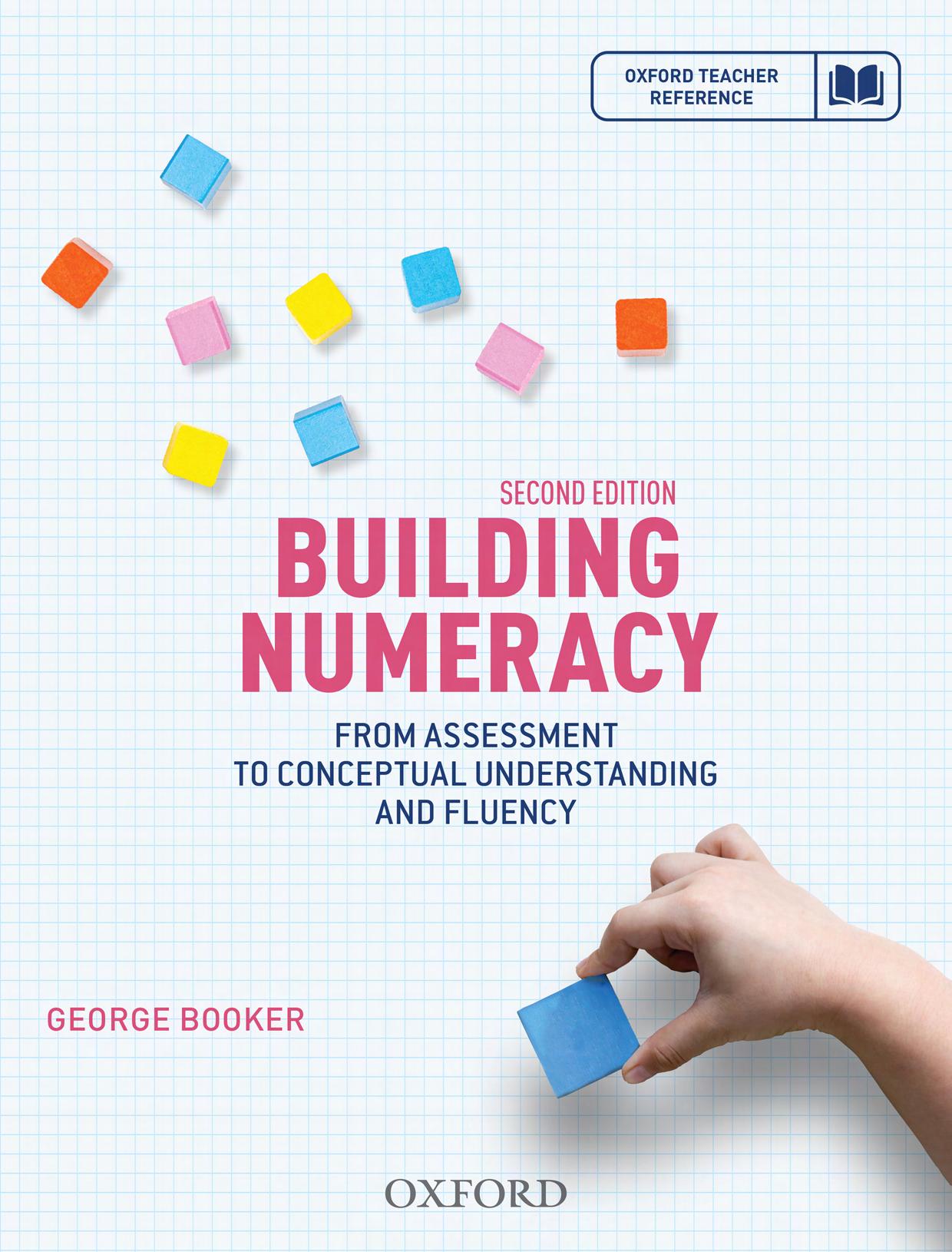


Numeracy, diagnosis and intervention
To be truly numerate involves considerably more than the acquisition of mathematical routines and algorithms, no matter how well they are learned. Students need to learn mathematics in ways that enable them to recognise when mathematics might help them to interpret information or solve practical problems, apply their knowledge appropriately in contexts where they will have to use their mathematical reasoning processes, choose mathematics that makes sense in the circumstances, make assumptions, resolve ambiguity and judge what is reasonable.
National Numeracy Review, p. xi, 2008
As technology becomes ever more central to all aspects of life, a more numerate population is required and so numeracy must be an essential goal of education. Indeed, as Robert Orrill (2001) remarked decades ago, we are living in a society ‘awash in numbers’ and ‘drenched in data’. It is no longer considered sufficient for children to study mathematics; they need to be able to use their mathematical knowledge in an ever-broadening range of activities, including STEM (Matt Larson, 2017) and to use statistics and interpret data (Education Council, 2015). Being comfortable and competent in thinking about numbers provides them with a basis to evaluate complex issues and concerns arising in work and everyday life. Individuals who lack an ability to think numerically will be disadvantaged, unable to participate in high-level work and at the mercy of other peoples’ interpretation and manipulation of numbers. It follows that ‘an innumerate citizen today is as vulnerable as the illiterate peasant of Gutenberg’s time’ (Steen, 1997); both literacy and numeracy are critical components for living productively in the third millennium.
The nature of numeracy
In many ways, numeracy can be thought of as a subset of school mathematics, the ‘basic mathematics’ needed for every day, or the foundations and building blocks of school mathematics. However, it can also be conceived of as somewhat more than mathematics, involving a grasp of the interplay between mathematics and the social contexts in which it is used (National Numeracy Review 2008, p. 3). Overall, numeracy is concerned with applying elementary ideas in sophisticated settings, rather than generalising ideas to more abstract concepts and more complex processes as in the study of mathematics as a discipline (Steen, 2001). An ability to solve problems, communicate the results and methods used to obtain solutions, interpret and use the results of mathematical processes, and make sense of the information are all essential to being numerate. The Australian Curriculum, Assessment and Reporting Authority (ACARA): Mathematics stated that:
Students become numerate as they develop the knowledge and skills to use mathematics confidently across other learning areas in school and their lives more broadly. Numeracy encompasses the knowledge, skills, behaviours and dispositions that students need to use mathematics in a wide range of situations. It involves students recognising and understanding the role of mathematics in the world and having the dispositions and capacities to use mathematical knowledge and skills purposefully.
ACARA, 2020
The Organisation for Economic Co-operation and Development (OECD) provides a succinct statement used to frame tests, such as PISA and PIAAC, that is helpful in planning for numeracy: Numeracy is defined as the ability to use, apply, interpret and communicate mathematical information and ideas. It is an essential skill in an age when individuals encounter an increasing amount and wide range of quantitative and mathematical information in their daily lives.
OECD, 2016
Thus, numeracy includes the content of elementary mathematics, number in particular since it is used to generalise to algebra and underpins geometry, measurement, statistics and probability, as well as a focus on problem solving, sense making and an ability to communicate with and about mathematics. The Australian Curriculum: Mathematics (ACARA, 2020) emphasises proficiencies of understanding, fluency, problem solving and reasoning across the content strands so that these too are essential aspects of numeracy.
Yet many students fail to achieve even minimal standards of numeracy and even those who do frequently say that they are ‘not good at maths’, feel inadequate and are unable to use the elementary mathematics that they have acquired. Such difficulties arise largely from insufficient earlier learning experiences, even when the actual errors are exhibited at quite a late point in the development of particular processes or applications. Inappropriate approaches, the introduction of material too soon, too late or too quickly, and an emphasis on symbols rather than the language by which mathematical ideas are gained or communicated are the major contributing causes.
What is needed are meaningful concepts for numeration and computation to provide: conceptual understanding of number; fluent processes in numeration and computation including renaming, rounding, automatic access to basic facts and a range of algorithms for computation with larger numbers; a capacity to draw on these concepts and fluent processes to solve problems; and reasoning about the methods and solutions in problem solving. Chapter 3 of Building Numeracy discusses the content and understanding needed to come to terms with numeration for whole numbers; computation across addition, subtraction, multiplication and division; fraction concepts; and the processes required to understand and use decimal fractions and common fractions. It also draws out the connections between these ideas, emphasising the importance of additive, multiplicative and algorithmic thinking as organisational frameworks for the development of problem solving and further mathematics, the algebraic thinking that leads into more formal algebra in particular. As Hiebert and Grouws (2007, p. 391) note:
Two features of classroom teaching facilitate students’ conceptual development (and mathematical proficiency), explicit attention to connections among ideas, facts and processes, and engagement of students struggling with mathematics.
Diagnosis of difficulties
To overcome the difficulties that students have, teachers need to be able to pinpoint weaknesses early and provide intervention in the form of programs suited to the learner’s needs. Such diagnosis needs to reveal what is known and what is not known, to identify how mathematics is understood and used, to highlight strengths that allow success, and to pinpoint the underlying causes of errors or misconceptions. Teacher observations of the ways in which students are working and thinking, or inferences made from samples of students’ work or workings, are critical in diagnostic assessment. However, it is not always easy to see just what students are doing in the mathematics they answer incorrectly or to determine why they act in that way.
Chapter 3 of this book provides an approach to diagnosis across all aspects of whole number and fraction numeration and computation, based on a cycle of observations–assumptions–probing that allows difficulties to be revealed and underlying causes to be determined. This approach allows a teacher to uncover the ways students are thinking, reveals any gaps in their understanding or processing, and points to a program of intervention that focuses on what needs to be known rather than addressing each error at a surface level, simply correcting the mistakes that are made. Examples of common errors and misconceptions are provided with an analysis of
each in terms of conceptual knowledge, confusion with or among procedures, and inappropriate generalisations from early ways of proceeding to situations where this thinking no longer applies.
A series of numeracy screening tests based on this approach to diagnosis has been provided in this book to allow a teacher to readily assess a class, small group of students or individuals. Feedback from educators on the use of Building Numeracy (2011) suggested that the inclusion of an early number interview to assess the knowledge and understanding of children beginning school would be beneficial, as well as comprehensive problem solving tests to be used across the school years. These have now been incorporated into this second edition.
While many of the tests used for class, school, state or national assessment provide a snapshot of students’ knowledge of particular topics, these screening tests are intended for diagnostic purposes. They provide a picture of strengths, weaknesses or gaps in understanding, fluency, and the ability of students to apply their mathematics in a relatively straightforward manner. As such, they can be used:
• for a whole class at the beginning of the year, semester or term; or prior to beginning a particular aspect of mathematics to see whether prerequisite knowledge is present
• to assess progress prior to and at the end of a teaching or intervention program, as two equivalent forms of each test are provided
• throughout the year and across year levels to determine whether material apparently gained at one point in time is still available when required at a later time, especially when a number concept or operation is used in measurement or problem solving
• with a par ticular group in a class to determine the origins of difficulties evident during teaching
• to check the depth of understanding and proficiency of talented students to ensure they are able to move on to further mathematics or to apply their knowledge in deeper ways.
The content has been organised according to an analysis of the concepts and processes needed across the primary years F–6 and middle years 7–9 of schooling. A user will be able to determine from their own or school program which questions are appropriate for a particular class by referencing the aspects addressed by each question (detailed at the start of each test) and the match of questions to the Australian Curriculum expectations. The table below outlines likely uses of the tests based on this conceptual analysis, expectations of what all students at a particular level should achieve, and evaluation by teachers. The numbers in columns refer to question numbers in the tests. This might mean that not all the questions on page 1 or page 2 of a test need to be completed. At the same time, students who show aptitude with the given range of questions should be challenged by later questions to see how far their capabilities extend.
Development of the numeracy screening tests
The need for these tests grew out of programs of research at the Mathematics Assistance Clinic at Griffith University in Brisbane, Queensland, and professional development offered to teachers through SPELD, Learning Difficulties Australia, Australian Council for Educational Research, and to schools, school districts and organisations throughout Australia and New Zealand. Diagnosis and Intervention programs at the Mathematics Assistance Clinic provided opportunities to finetune the assessment items. Discussions on the format of the screening tests, the responses given by those being assessed, the reasons for particular patterns of thinking provided by students studying in the Mathematics Assistance Clinic, and feedback from graduate students using the tests in their studies have been invaluable in conceptualising the structure and format of the tests.
The tests and records were then trialled across a range of classes, schools and year levels in both primary and secondary settings to validate the conceptual analysis of the test areas and to check whether these did provide a fair measure of students’ mathematical needs. Critical feedback was obtained from mathematics education and special education lecturers around Australia, and this included additional data from teachers who used the screening tests with their primary classes. This also gave opportunities to adjust the tests to ensure that they were easy to use so that teachers could mark the questions and readily transfer the data to the score sheets to obtain information about whole class and individual performance.
The order in which the items were given, the wording and contexts of the questions, and the balance among the question types were also investigated, leading to a more helpful ordering of the questions on the page and reduction in complexity, so that each question unambiguously addressed only one essential aspect. Particular attention was paid to the placing of the oral basicfact questions, the spread of problem solving and concept items, and the layout of the larger number examples for each computation sub test. The two fraction tests were trialled in different forms to find a suitable way of allowing for student working and recording of their results. While placing a fraction on a number line is fundamental to the concept of a fraction as a number, this proved to be very difficult for many students and was made the final fraction question to provide a full measure of fraction understanding.
Experience with the classes and schools used in the trialling of these tests suggests that there are many students who will find questions difficult across the whole of a topic. In particular, there appears to be a large cohort of students in secondary school that find the multiplication and division questions beyond their ability, and also struggle with many of the conceptual questions directed at fraction ideas. As it is these ways of thinking that both underpin algebra and need to be generalised to provide the conceptual basis for algebraic reasoning, it would be advised to give these tests to students at the start of their high school mathematics program to determine whether they have a sufficient basis in them to build up these new forms of mathematics.
Overall, the numeracy screening tests provide an effective and time efficient means of determining both individual and whole class competence across a range of fundamental numeration and computation concepts and processes for whole numbers and fractions. When an individual or small group shows gaps in this knowledge, a teacher can tailor experiences for individual learners and provide activities to help them construct needed concepts or processes. In some instances, however, further probing may be necessary to determine where the gaps in an individual’s understanding occur. In these cases, additional information can be gained by using the Booker Profiles in Mathematics: Numeration & Computation – Revised (2009) and the Booker Profiles in Mathematics: Problem Solving – Revised (2009) to pinpoint more finely those aspects that
are known and those that still need to be developed. When the assessment reveals that the whole class is lacking particular aspects, the class program can be amended to build up these essential understandings needed to allow generalisations to new knowledge.
Intervention and mathematics learning
When students experience difficulties in mathematics, they will need assistance to overcome them Ideally, any difficulties should be identified early and assistance provided to address the needs revealed by a diagnosis of the difficulties. Such intervention focuses on providing support within a teaching sequence as soon as a difficulty is noted or anticipated as an essential element of ongoing learning, so every student can develop the conceptual understanding and fluent processes needed to acquire and use mathematics.
Chapter 4 provides an overview of the intervention process, focusing on determining the underlying causes of any difficulties, leading a student to see inadequacies in their ways of proceeding and thus appreciate a need to change, and implementing means of building appropriate ways of thinking, generalising and applying mathematical ideas. The types of activities that engage learners, the manner in which concepts and process can be modelled, and the power of using instructional games to motivate and provide meaningful practice are examined across the range of errors revealed through the numeracy screening tests and in everyday classroom experiences. The tests provided are intended for diagnostic purposes and give a snapshot of strengths, weaknesses or gaps in mathematical applications.
These ideas are then brought together to provide a basis for constructing appropriate programs of intervention for whole classes, groups of students or individuals. It is important that numeration, additive thinking and multiplicative thinking build from each other to provide the foundations for new learning, and that concepts and processes form a connected whole rather than be viewed as a series of isolated procedures. This critical aspect of building numeracy is discussed in detail in Chapter 6, along with suggestions for providing intervention approaches to the questions typically included in national testing programs such as the National Assessment Program in Literacy and Numeracy, commonly known as NAPLAN, which from 2016 has been aligned with the Australian Curriculum: Mathematics (ACARA, 2020).
Building numeracy in all students is a critical aspect of contemporary schooling. This book has been written to assist all teachers, at all levels and across the curriculum, to develop expertise and confidence in diagnosing student difficulties. Understanding how concepts and processes are constructed and connected provides a basis for overcoming misconceptions and inappropriate ways of thinking that students may have developed. Appropriate intervention programs can then be planned and implemented to build students’ competence and confidence with fundamental mathematical ideas. In this way, students will be prepared to engage with further mathematical ideas and be inclined to use their knowledge of mathematics in the many everyday and work contexts where reasoning and sense-making will be required.






















